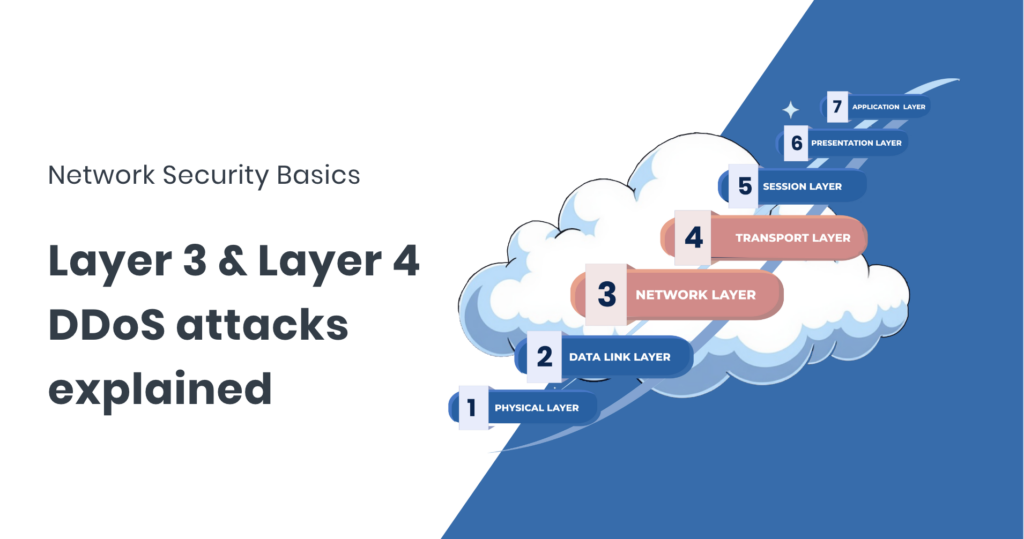What L3 and L4 DDoS attacks are, how they work, and what defenders need to know
DDoS attacks at Layers 3 and 4 (the Network and Transport layers) are some of the most common and disruptive seen on the public internet. While often lumped together, they behave differently, and defending against them requires understanding how they work.
Here’s a breakdown of both layers, common attack types, and tips for mitigation based on real-world experience.
What is a Layer 3 DDoS attack?
Layer 3 (Network Layer) handles IP routing and delivery between networks. Attacks at this layer typically aim to overwhelm routing infrastructure or links, making services unreachable.
Common Layer 3 attack types:
- ICMP floods: Attackers send high volumes of ICMP (ping) packets to consume bandwidth or exhaust CPU resources on routers and firewalls.
- IP fragmentation attacks: Send malformed or overlapping IP fragments to confuse reassembly logic in devices, causing drops or crashes.
- Smurf attacks (less common today): Exploit broadcast addresses to amplify ICMP traffic via spoofed source IPs.
The impact:
- Saturated links
- Router CPU exhaustion
- Dropped connections and full outages
What is a Layer 4 DDoS attack?
Layer 4 (Transport Layer) deals with protocols like TCP and UDP that enable communication between devices. Layer 4 DDoS attacks typically exploit open ports or connection states to drain server or firewall resources.
Common Layer 4 attack types:
- UDP floods: High-rate, stateless floods targeting common ports (e.g. DNS/53, NTP/123). Easy to spoof and amplify.
- TCP SYN floods: Exploit the TCP handshake by sending floods of SYN packets and never completing the connection. Servers wait and exhaust available sessions.
- TCP RST/ACK floods: Abuse legitimate TCP response mechanisms to clog state tables or confuse session tracking logic.
The impact:
- Exhausted port listeners or connection queues
- High CPU on stateful firewalls
- Service latency, resets, or full failure
How L3 and L4 compare to L7
Layer 7 (Application Layer) DDoS attacks target specific applications (like HTTP, DNS, or APIs) with the goal of exhausting resources with what appears to be legitimate traffic.
While L7 attacks are more targeted, L3 and L4 floods are often more volumetric, and are the types of attacks that most often trigger automatic blackholing, BGP-based filtering, or upstream rate-limiting.
FastNetMon focuses on detecting and mitigating Layer 3 and Layer 4 attacks in real time -long before they reach the application layer.
Detection & mitigation: what works
Layer 3 and 4 attacks often require mitigation within seconds to avoid full service degradation. Some effective strategies include:
RTBH (Remote Triggered Black Hole)
- Used for fast, coarse null-routing of attacked IPs
- Great for link protection during volumetric floods
BGP Flow Spec
- Enables granular, rule-based filtering on routers
- Useful for filtering based on specific protocol, port, and packet fields (e.g. UDP/53 floods)
Traffic Analysis & Thresholding
- Monitoring NetFlow/sFlow/IPFIX lets you catch anomalies in volume, source diversity, and protocol usage
- Smart thresholding reduces false positives and triggers appropriate mitigation in real time
Key Differences: Layer 3 vs Layer 4
| Feature | Layer 3 Attacks | Layer 4 Attacks |
|---|---|---|
| Protocols Used | ICMP, IP fragments | TCP, UDP |
| Attack Goal | Overwhelm network/routing | Exhaust transport/session layers |
| Detection Signals | Packet rate, ICMP spikes | Port targeting, TCP flag spikes |
| Typical Mitigation | RTBH, Flowspec (IP-based) | Flowspec (port-based), state handling |
| Spoofing Feasibility | High | High (esp. UDP floods) |
| Impact Radius | Network-wide | Targeted but infrastructure-heavy |
Layer 3 and Layer 4 DDoS attacks remain the bread and butter of volumetric threats today. While not as complex as application-layer attacks, they’re faster, harder to spot without flow visibility, and can take entire services offline in under a minute.
If you’re running edge infrastructure, hosting services, or operating a transit network, real-time detection and automated mitigation for L3/L4 threats isn’t optional; it’s operational hygiene.
About FastNetMon
FastNetMon is a leading solution for network security, offering advanced DDoS detection and mitigation. With real-time analytics and rapid response capabilities, FastNetMon helps organisations protect their infrastructure from evolving cyber threats. For more information, visit https://fastnetmon.com

